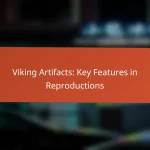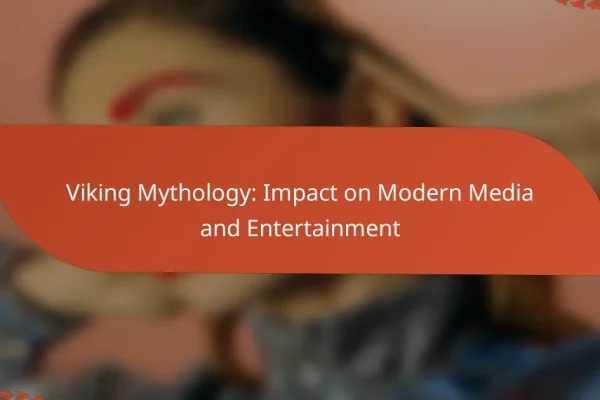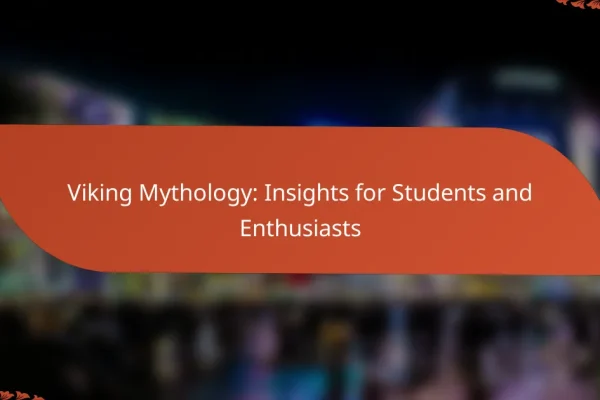How does Viking mythology influence modern literature?
Viking mythology significantly shapes modern literature by providing rich narratives, themes, and character inspirations. Elements such as gods, mythical creatures, and epic quests resonate in contemporary storytelling, particularly within fantasy genres.
Influence on fantasy genres
The impact of Viking mythology on fantasy genres is profound, often serving as a foundation for world-building. Authors draw from Norse legends to create immersive settings filled with gods, giants, and magical realms. Popular series like “The Lord of the Rings” and “A Song of Ice and Fire” incorporate these mythological elements, enhancing the sense of adventure and conflict.
Many fantasy novels feature quests that echo the journeys of Norse heroes, emphasizing themes of bravery, honor, and fate. This connection to Viking lore allows readers to explore complex moral dilemmas and the struggle between good and evil in a familiar yet fantastical context.
Character archetypes in contemporary novels
Viking mythology introduces distinct character archetypes that frequently appear in modern literature. The archetypal hero, often depicted as a warrior with a strong moral compass, can be traced back to figures like Thor and Sigurd. These characters typically face overwhelming odds, embodying traits such as courage, loyalty, and resilience.
Additionally, the presence of trickster figures, akin to Loki, adds depth to narratives, allowing for complex character dynamics and unexpected plot twists. Authors often utilize these archetypes to create relatable characters that resonate with readers, fostering a connection to ancient stories.
Symbolism in popular series
Symbolism derived from Viking mythology enriches the themes and motifs in popular literature. For instance, the Yggdrasil tree, representing the interconnectedness of worlds, is often referenced to illustrate the links between different realms or characters’ fates. This symbolism enhances the narrative depth and invites readers to explore underlying meanings.
Moreover, symbols such as runes and mythical creatures like dragons serve as powerful motifs that convey cultural significance and moral lessons. Authors leverage these symbols to create a sense of continuity between ancient beliefs and modern storytelling, making the narratives more engaging and thought-provoking.
What are the key themes in Viking mythology?
Key themes in Viking mythology include fate and destiny, heroism and valor, and the relationship between nature and the cosmos. These themes reflect the values and beliefs of the Norse people, shaping their understanding of life, death, and the universe.
Fate and destiny
Fate and destiny play a crucial role in Viking mythology, often represented by the concept of “wyrd,” which signifies the interconnectedness of events and choices. Norse gods and heroes frequently confront their fates, suggesting that while destiny is predetermined, individuals can influence their paths through actions and bravery.
The Norns, three female beings who weave the fate of gods and men, symbolize this theme. They emphasize that while one’s fate may be set, the manner in which one faces it defines their legacy. Understanding this can inspire individuals to act courageously, knowing their choices matter.
Heroism and valor
Heroism and valor are celebrated in Viking mythology, often exemplified by legendary figures like Odin, Thor, and the warriors of Valhalla. These stories highlight the importance of courage in battle and the pursuit of honor, reflecting the warrior culture of the Norse people.
Valiant acts are rewarded in the afterlife, where fallen warriors are welcomed into Valhalla, reinforcing the idea that bravery leads to eternal glory. This emphasis on heroism encourages individuals to strive for greatness and face challenges head-on, embodying the ideals of strength and honor.
Nature and the cosmos
The relationship between nature and the cosmos is a central theme in Viking mythology, illustrating how the natural world is intertwined with the divine. The cosmos is often depicted as a tree, Yggdrasil, which connects the nine realms, symbolizing the unity of all existence.
Nature is revered, with gods and goddesses representing various elements, such as Freyja for fertility and Njord for the sea. This connection encourages respect for the environment and an understanding of humanity’s place within the larger universe, reminding individuals to live in harmony with nature.
How is Viking mythology represented in film and television?
Viking mythology is prominently featured in film and television, often focusing on the rich narratives of Norse gods, legendary heroes, and epic battles. These adaptations bring ancient tales to life, blending historical elements with creative storytelling to engage modern audiences.
Major films inspired by Viking tales
<p Numerous films have drawn inspiration from Viking mythology, showcasing the dramatic and often violent lives of Norse warriors. Notable examples include "The 13th Warrior," which combines historical fiction with myth, and "Valhalla Rising," which explores themes of fate and the afterlife.
These films often emphasize the heroic journeys of characters like Ragnar Lothbrok, a legendary Viking king, and the moral dilemmas faced by warriors in their quest for glory and honor. The visual representation of Viking culture, including their ships and battles, adds depth to these cinematic experiences.
Television series depicting Norse gods
Television has also embraced Viking mythology, with series like “Vikings” and “Norsemen” gaining popularity for their engaging storytelling and character development. “Vikings” follows the legendary exploits of Ragnar and his family, intertwining historical events with mythological elements.
In contrast, “Norsemen” offers a comedic take on Viking life while still referencing Norse gods and beliefs. These series highlight the cultural significance of mythology in shaping the identity and values of Viking society.
Documentaries exploring Viking beliefs
Documentaries provide a factual exploration of Viking beliefs and mythology, often delving into archaeological findings and historical texts. Programs like “The Real Vikings” examine the spiritual practices of the Norse people, including their reverence for gods like Odin and Thor.
These documentaries often feature expert interviews and visual reconstructions, helping viewers understand the complexities of Viking spirituality and its influence on their daily lives. They serve as an educational resource for those interested in the historical context of Viking mythology.
What role does Viking mythology play in modern art?
Viking mythology significantly influences modern art by providing rich themes, symbols, and narratives that artists draw upon. This ancient belief system inspires various art forms, allowing contemporary creators to explore cultural identity, heroism, and the human experience through a mythological lens.
Influence on visual arts
Viking mythology permeates visual arts, with artists often depicting gods, legendary creatures, and epic battles. The use of Norse symbols, such as the Valknut or Mjölnir, can be seen in paintings, murals, and digital art, reflecting a fascination with the mythology’s dramatic narratives. Artists may also incorporate traditional Viking motifs into modern styles, creating a fusion that resonates with both historical and contemporary audiences.
Contemporary sculptures and installations
Modern sculptures and installations frequently draw inspiration from Viking mythology, using materials like stone, metal, and wood to create pieces that evoke the era’s craftsmanship. These artworks often represent mythological figures or scenes, inviting viewers to engage with the stories behind them. For instance, public installations may feature large-scale representations of Norse gods, enhancing cultural heritage in urban spaces.
Graphic novels and illustrations
Graphic novels and illustrations have embraced Viking mythology, offering vibrant retellings of ancient tales. Artists in this medium utilize dynamic visuals to bring characters like Thor and Loki to life, making the stories accessible to new generations. The blend of traditional storytelling with modern graphic techniques allows for innovative interpretations, often appealing to both enthusiasts of mythology and casual readers alike.
How does Viking mythology impact gaming culture?
Viking mythology significantly influences gaming culture by providing rich narratives, compelling characters, and immersive worlds. Many games draw on Norse gods, legends, and themes, creating engaging experiences that resonate with players.
Popular video games featuring Norse mythology
Several popular video games incorporate Norse mythology, enhancing their storytelling and gameplay. Titles like “God of War” and “Assassin’s Creed Valhalla” explore themes of fate, honor, and the pantheon of Norse gods, allowing players to interact with iconic figures such as Odin and Thor.
These games often blend historical elements with mythological lore, creating a unique atmosphere that captivates players. The use of Norse settings and characters not only enriches gameplay but also introduces players to the cultural significance of Viking beliefs.
Tabletop games inspired by Viking lore
Tabletop games have also embraced Viking lore, offering players a chance to engage with mythological elements in a social setting. Games like “Blood Rage” and “Runewars” incorporate Viking themes, allowing players to strategize and compete in scenarios inspired by Norse legends.
These games often include components such as miniatures and cards that reflect Viking culture, enhancing the immersive experience. Players can explore themes of conquest, survival, and mythology while enjoying the tactile nature of tabletop gaming.
Role-playing games and character creation
Role-playing games (RPGs) frequently utilize Viking mythology in character creation and world-building. Systems like “Dungeons & Dragons” offer options for players to create characters inspired by Norse gods and mythical creatures, adding depth to their narratives.
Players can choose classes and backgrounds that reflect Viking traits, such as warriors, seers, or shieldmaidens. This flexibility allows for diverse storytelling and character development, making each gaming session unique and engaging.
What are the connections between Viking mythology and Scandinavian culture?
Viking mythology is deeply intertwined with Scandinavian culture, influencing language, art, and traditions. The myths of gods like Odin and Thor are reflected in modern Scandinavian folklore, literature, and even place names.
Influence on Language
The impact of Viking mythology on Scandinavian languages is significant, with many terms and expressions rooted in mythological references. Words related to days of the week, such as “Thursday” (Thor’s day), showcase this connection. Additionally, many modern Scandinavian languages retain vocabulary that can be traced back to Old Norse, the language of the Vikings.
Art and Literature
Viking mythology has inspired a wealth of artistic expression in Scandinavia, from ancient carvings to contemporary literature. Norse myths are often depicted in traditional crafts, such as woodwork and textiles, and have influenced modern authors like J.R.R. Tolkien and Neil Gaiman. This ongoing inspiration keeps the stories alive in various forms, including graphic novels and films.
Festivals and Traditions
Many Scandinavian festivals and traditions have roots in Viking mythology, celebrating the changing seasons and honoring the gods. For instance, Midsummer festivals often incorporate elements from ancient rituals, such as bonfires and maypole dancing, reflecting a connection to nature and mythology. These celebrations foster a sense of community and cultural identity among the Scandinavian people.










